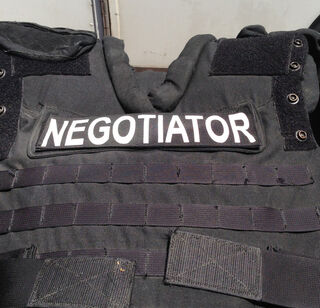Body Language
Hostage & Crisis Negotiators: Nonverbal Communication Basics
Learn the skills used by these expert negotiators and see how they can help you.
Posted August 13, 2013 Reviewed by Ekua Hagan

Law enforcement crisis and hostage negotiators are world-renowned for their ability to apply expert conflict resolution and communication skills in situations that are tense, (potentially) volatile, and where lives can be at risk.
Learning the skills that these professionals apply to their distinct negotiation settings is not only interesting but can also help you. Although their work is most likely very different from yours, the tools they use to effectively communicate and resolve a situation can still be applicable to you and your work.
Nonverbal communication plays an important role during hostage and crisis situations involving law enforcement personnel. Nonverbal communication is not limited to solely “body language” but rather includes a variety of other elements. To raise awareness of the numerous nonverbal communication elements that are possibly present during an interaction, I created the METTA acronym (movement, environment, touch, tone, and appearance) during my doctoral research on nonverbal communication and mediators.
Below, I have applied the METTA acronym to the hostage and crisis negotiation setting offering an introductory look at how nonverbal communication can impact the negotiations while also offering insight into the skills used by these professionals.
Movement. Congruent body movement that is matching the words being spoken helps display genuine empathy while also contributes to developing rapport and building trust. Even when communication signals are limited such as just talking via phone, it still plays an important role. Think about the next time you are on the phone and notice how often you nod your head, use hand gestures, and use paralanguage such as “mmm” to express agreement or understanding.
Environment. The environment is one of the first factors responding police personnel address when responding to a crisis or hostage situation. Securing the scene is vital to prevent injury and containing the situation by establishing a secure perimeter is the first priority according to crisis and hostage negotiation researcher Lawrence Miller, Ph.D. Securing the scene, besides for safety reasons, also removes distractions during the negotiation process.
Another aspect that is part of “environment” is time. Chronemics is the study of time. In crisis/hostage negotiations, time is important and it is recommended to not rush the process. Retired FBI chief negotiator of the famed Crisis Negotiation Unit, Gary Noesner, emphasizes the importance for a negotiator to not rush things as “buying time usually leads to better decision-making by everyone involved.” Also, an important trait for negotiators in regards to time is the ratio he or she spends listening compared to speaking. Expert crisis/hostage negotiators spend much more time listening than speaking.
Listening, among many important reasons, allows the other person to speak and share their perspective on what has led the particular situation from arising. This can contribute to reducing their actions stemming from their emotions and now acting from a cognitive perspective.
Touch. In the crisis/hostage negotiation setting, I refer to touch in regards to “leakage.” The Harvard Business School's Amy Cuddy did a brilliant TED talk showing how acting confident can increase thoughts of being confident, yet her research demonstrates the reverse can be true too. Leakage, or unintentional body movement and actions, can contribute to diminishing confidence. Further, certain posture positions, fidgeting, and self-touching (think playing with your ring, your hair, or touching the back of your neck) can be a sign of anxiety and stress.
Being calm, a necessary trait of crisis/hostage negotiators, can diminish with these actions. A negotiator’s awareness of these actions can help them prevent or stop themself from doing it. Also, noticing it in others can help the negotiator address it properly through specific actions such as checking in by asking an open-ended question.
Tone. A crisis/hostage negotiator’s voice tone is an important tool that can help de-escalate the situation or contribute to the chaos. Retired FBI special agent and crisis negotiator Chuck Regini states, “Good crisis negotiators must have the ability to remain calm under emotionally demanding situations.”
While communicating with the person, your voice tone, when used strategically, can display this calmness and can help reduce the tension of the situation. A calm voice tone can also establish trust and rapport, and display genuine empathy. These three skills have consistently been demonstrated in research studies as being used by negotiators to contribute to peaceful resolutions.
Appearance. Being properly dressed for a crisis/hostage situation includes, aside from personnel being armed with the necessary tactile equipment, having distinctive clothing identifying the negotiator(s). Crisis/hostage negotiating is a team sport, and each person has a specific role. Aside from the immediate team, there are other personnel present and the last thing you want is a negotiator being mistaken for someone else and vice versa.
This post has given a brief, introduction to nonverbal communication skills and elements that play a critical role in crisis and hostage situations. Each can also play an important role in your professional life too. Consider, for example, how nodding your head and displaying other nonverbal actions can signal you are listening; allowing people to speak can reduce a tense discussion; constant interruptions can break everyone’s attention span; fidgeting with your wedding ring can reduce the effectiveness of your speech; your tone can let a co-worker know you genuinely care about their issue, and how your choice in clothing can complement the message you are trying to deliver.
You might not be a crisis/hostage negotiator, but there is much that can be learned from them with the result making you a better communicator.
Jeff's posts represent his own views and opinions—not that of any organization he is employed by or is a member of.
References
Miller, L. (2005). Hostage negotiation: Psychological principles and practices. International Journal of Emergency Mental Health, 7(4), 277-298.
Noesner, G. (2008). From training material.
Regini, C. (2002, November). Crisis negotiation teams: Selection and training. The FBI Law Enforcement Bulletin, 71(11). 1-5.




